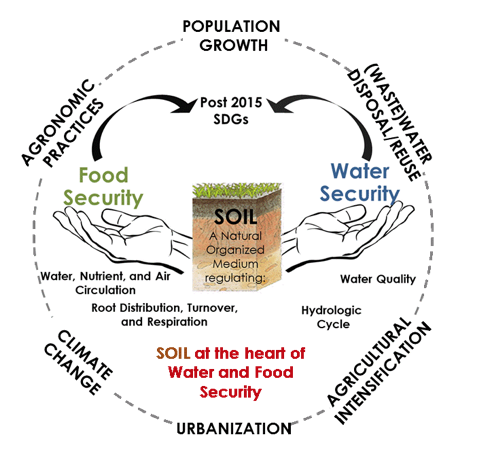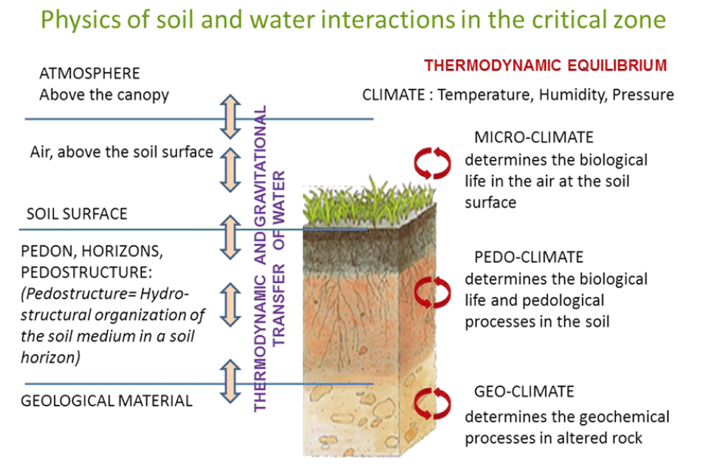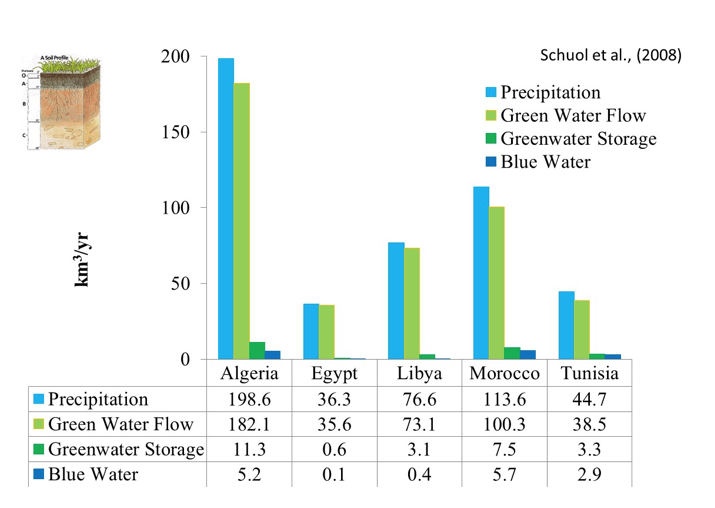The Role of Soils in Global Water and Food Security
Developing policies and strategies for global resource security (water and food) are critical to the healthy future of our planet. The world today faces an increase in the amplitude and frequency of dynamic stresses that greatly challenges our ability to provide effective policies and strategies. We believe that one limiting factor for this challenge is the lack of an adequate, standard quantitative representation that incorporates both the nature of the resource and its natural functionality. Such a quantitative representation would enable the establishment of interdisciplinary linkages dealing with the same resource. As an example, we focus on the soil, a vulnerable and non-renewable natural resource that plays an imperative role in building and enhancing national sustainable water and food security programs. Soil is a hierarchically organized, living medium. Each soil type has its own unique organization or "structure". This unique structure enables the soil to perform various functions: maintaining life and biodiversity, contributing to energy production and climate sustainability, forming the infrastructure for the production of food, fiber and fresh water for Earth’s more than 7 billion inhabitants.
This article explores the role of soil in bridging the food security gap with special focus on North Africa. It also makes a call for more research investment in fundamental soils and water research in order to secure and maintain the roles of healthy soil for the benefit of global economic security.
Soil: A Complex Living Medium
Soil is a living medium which hosts biological, chemical and physical activities that support human life on this planet. Soil water management, its quantity and quality alike, is critical not only for food security but also for water security.
Figure 1. Role of Soil in Global Water and Food Security (Mohtar, 2015)

Figure 1 illustrates the role of soils in sustaining food and water resources, and providing ecosystems services (Mohtar, 2015). The figure highlights the potential role of soils, if properly managed, as providers of food security in food production systems and of water security in terms of water quality and quantity. Proper soil water management reduces the demand for fresh water for agriculture (food production) and allows soil to behave as “nature’s kidney” in decontaminating our fresh water sources. Healthy soils are critical to supporting human activities, however, soils too have been stressed by agricultural intensification, urbanization, and unsustainable agricultural practices that lead to reduction in soil quality, eroding this same resource so vital to future water and food security. This article explores these issues and offers fresh ideas and perspectives into soil as a critical living resource that needs to be preserved.
The high level discussions encountered make it clear that to meet the challenges of climate change and demographics, we must understand and optimize agricultural practices and the management of agricultural/ecological systems. This key point requires that we address two specific knowledge gaps: i) simulation tools of the functioning and evolution of the agrosystem or ecosystem under consideration; and ii) associated information system, geospatially referenced, that store the characteristics and parameters required by these tools. These tools can be used to model the soil–plant–atmosphere system in accordance with the local conditions of the natural environment (soils, climate) and land use. The major problem these tools must overcome is the hierarchized organization scales and the transfer of information from a local (occurrence of processes in the soil medium, where physical modeling is appropriate), to a global scale (where the effects of the processes are globally and statistically modeled as phenomena appearing at the soil surface). The questions of interdisciplinary relationships, uncertainties of data, and sustainability of agro/ecosystems arise from the difficulty of transferring information across scales and of determining which information is to be transferred.
Accordingly, there is a need to consider, appreciate, and characterize the soil medium organization or "soil structure" as it exists in nature, including its thermodynamic interaction with the surrounding environment. Current soil databases lack these attributes. Only with their inclusion are we able to answer two grand challenge questions:
1. What are the long term impacts of current agro-environmental practices and/or the impact of climatic change on soil functionality, and, consequently, on water and food securities? Considering soil organization as the key player in determining soil functionality, this organization reacts thermodynamically with the surrounding climate. Therefore, it is very important to have thermodynamic and soil-structure based systems of equations (i.e. fundamentals, state variables and parameters). This is of particular importance if the parameters of these equations are measurable and each characterizes a specific property within the thermodynamic system.
2. With regard to transferring knowledge across scales, soils do exist in a hierarchical organization that begins with the soil particles and continues through aggregates, soil horizon, pedon, soil unit, geomorphological unit, and so forth. This fact must be better utilized in agro-environmental models, which must also consider soil organization, thermodynamically characterize the soil organization, then model the thermodynamic equilibrium/interaction with the surrounding environment. Figure 2 describes the soil- plant-atmosphere continuum and interactions. It also describes the interactions between soil processes and the microclimate, important feedback in agriculture areas. These linkages and feedbacks must be quantified and incorporated into current local climate models. Today’s challenge in agro-environmental science lies in understanding our resources in terms of their nature and the ability to transfer this understanding into physical and mathematical models by developing a set of measurable physical parameters and state variables that describe the thermodynamic interactions of the soil organization with its surrounding environment.
Figure 2. Modeling the soil-plant-atmosphere as an organized system in thermodynamic equilibrium dependent upon the local water content (Braudeau and Mohtar, 2014).

Soil medium is a complex multiscale system that shrinks and swells. Its structure evolves over time and as a function of its original parent material and the management system to which it is subjected. This evolution and the accompanying changes in soil organizational structure must also be reflected in our representation of soil. Figure 3 describes the structure-evolution-properties axis that governs soil behavior. This is a dynamic representation and allows us to represent and quantify soil functionality, consistent with the role and scaling challenges described earlier. Such representation allows us to quantitatively evaluate the impacts of soil practices such as tillage on soil performance and on farm management practices such as the reuse of water including irrigating with wastewater and other soil additives.
Figure 3. Soil representation: structure and evolution (Braudeau and Mohtar, 2009)

A Call for a green water revolution
The soil characterization framework outlined above allows us to better understand and optimize soil resources, particularly soil water (green water), which is a foundational resource for food production. The majority of the food produced globally is rain-fed and relies on soil water. Thus, this understanding is critical for localizing resources management and reducing the food supply chain. For example, increased productivity of green water as a mainstream production system will reduce reliance on energy intense water pumping (thereby reducing the water and energy footprints of food). This requires a new and different understanding of soil medium and points to the need for greater investment in basic research on soil functionality and the manner in which soil will react to anticipated changes in the future, such as the changes already seen in soil functionality due to wastewater reuse; particularly green water and its management for water and food scarcity and greater on-farm energy efficiency. This would support resilience and reduce supply chain length. Primary resources are essential to sustain our communities; enhancing the role of local primary resources and reducing the supply chain also address many of the issues of urban farming.
Implications for North African Countries
Figure 4 shows an accounting for the major water pools in Algeria, Egypt, Libya, Morocco and Tunisia. Precipitation is portioned into greenwater water flow (water passing through the soil medium and eventually leaving that medium through deep percolation, or emerging as downstream surface water but not stored in the soil profile) and blue water (free water stored both on surface and subsurface). The only potentially productive water in this analysis is greenwater: precipitation water stored in the soil profile and potentially used by plants. The greatest portion of precipitation goes to greenwater flow, which may somehow be harvested. This water is nearly double the blue water portion for the countries analyzed. This source is not given much attention, despite the fact that greenwater is the one most likely to be productively used in food production, allowing blue water to be saved for other human uses.
Figure 4. Average Available and Renewable Water in North Africa (km3/yr) (Mohtar, 2015, data source Schoul et al.)

Concluding remarks
In conclusion, I would like to highlight the following:
1. Soil Security is critical to achieving implementation of the post-2015 SDGs (water, food, climate, energy nexus goals).
2. Water–Energy–Food nexus security requires recognition of the soil as a natural, hierarchal, organized medium.
3. Quantitative approaches to studying the long term impact of agro-environmental practices on soil functioning is highly needed.
4. Valuing water and energy resources are vital to the sustainability of food production system.










